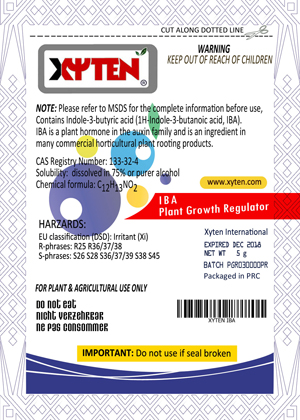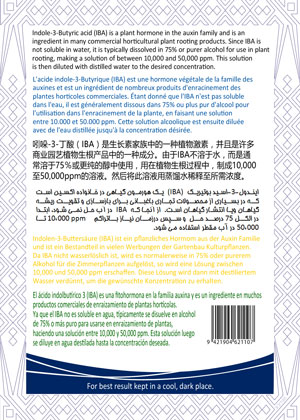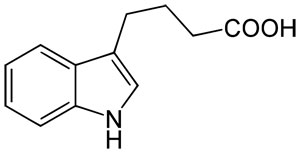Plant growth regulator
Indole Butyric Acid APPLICATION:
It can stimulate rooting system of plants and cuttings’ (herbaceous and woody ornamental), it can increase various fruits and melons’ fruit setting rate. It can promote cell division and cell growth, increase errant roots and fruitage; to prevent plants from dropping fruit, to change the ratio of male and female flowers; it also can get inside the plant through leaves and cortices to reach the action point with the nutrient flow.
CAS No. :133-32-4
Chemical Name:1h-indole-3-butanoic acid,3-indolebutyric acid,3-indolyl-gamma-butyric acid,4-(3-indolyl)butyric acid,4-(indol-3-yl)butyric acid,beta-indolebutyric acid;4-(indolyl)-butyric acid
Auxin is one of five (or more) major plant hormones (Auxin, Cytokinins, Gibberellins, Ethylene and Abscisic acid) which affect numerous plant growth processes functions including cell division and elongation, autumnal loss of leaves, and the formation of buds, roots, flowers, and fruit. Auxin action is inhibited by light which is an important role of the growth of stems toward light (phototropism), against the force of gravity (geotropism) and positively hydrotropic (moisture-seeking). The cells exposed to light don't grow as quickly as those on the shaded side, and thus the plant grows toward the light source. Auxins usually have a ring system with at least one double bond and attached by a side-chain that terminates in a carboxyl group. Indole acetic acid is the exact structure of Auxin activity. Parent compounds of auxin action are;
- Auxins
- 4-Chlorophenoxyacetic acid (CAS RN: 122-88-3)
- (2,4-Dichlorophenoxy)acetic acid (CAS RN: 94-75-7)
- 4-(2,4-Dichlorophenoxy)butyric acid (CAS RN: 94-82-6)
- Tris[2-(2,4-Dichlorophenoxy)ethyl] phosphite (CAS RN: 94-84-8)
- 2-(2,4-Dichlorophenoxy)propanoic acid (CAS RN: 120-36-5)
- 2-(2,4,5-trichlorophenoxy)propanoic acid (CAS RN: 93-72-1)
- Indole-3-acetic acid (CAS RN: 87-51-4)
- Indole-3-butyric acid (CAS RN: 133-32-4)
- 1-Naphthaleneacetamide (CAS RN: 86-86-2)
- 1-Naphthaleneacetic acid (CAS RN: 86-87-3)
- 1-Naphthol (CAS RN: 90-15-3)
- Naphthoxy acetic acid (CAS RN: 120-23-0)
- Naphthenic acid, inorganic salts (potassium, sodium)
- (2,4,5-Trichlorophenoxy) Acetic acid (CAS RN: 93-76-5)
- Antiauxins
- Clofibric acid (CAS RN: 882-09-7)
- 2,3,5-Triiodobenzoic acid (CAS RN: 88-82-4)
- Adenine (CAS RN: 73-24-5)
- Adenine Hemisulfate salt (CAS RN: 321-30-2)
- 6-Benzylaminopurine (CAS RN: 1214-39-7(base), 162714-86-5(HCl)
- N-Benzyl-9-(2-tetrahydropyranyl)adenine (CAS RN: 2312-73-4)
- N-(2-Chloro-4-pyridyl)-N'-phenylurea (CAS RN: 68157-60-8)
- 6-(gamma,gamma-Dimethylallylamino)purine (CAS RN: 2365-40-4)
- 1,3-Diphenylurea (CAS RN: 102-07-8)
- Kinetin (CAS RN: 525-79-1 (base), 177966-68-6 (HCl)
- 1-Phenyl-3-(1,2,3-thiadiazol-5-yl) Urea (CAS RN: 51707-55-2)
- Zeatin (CAS RN: 13114-27-7)
- trans-Zeatin (CAS RN: 1637-39-4 (base), 6025-81-6 (HCl))
- trans-Zeatin riboside (CAS RN: 6025-53-2)
- Abscisic acid (CAS RN: 21293-29-8)
- Ancymidol (CAS RN: 12771-68-5)
- Chlorocholine chloride (CAS RN: 999-81-5)
- Daminozide (CAS RN: 1596-84-5)
- 3,6-Dichloro-o-anisic acid (CAS RN: 1918-00-9)
- Gibberellic acid (CAS RN: 77-06-5)
- Gibberellic acid Potassium salt (CAS RN: 125-67-7)
- Gibberellin A4 (CAS RN: 468-44-0 ) and other gibberellins (more than 110 gibberellins are known)
- Glyphosate (CAS RN: 1071-83-6)
- Jasmonic acid (CAS RN: 3572-66-5)
- 1,3,5-Trihydroxybenzene (CAS RN: 108-73-6)
Cytokinin is a N6-substituted adenines acting as phytohormones such as kinetin, zeatin, 6-isopentenyladenine, benzyl adenine. The principal functions are stimulate cell division in concert with auxin (cytokinesis) and influence the pathway of tissue differentiation (organogenesis). 6-Benzylaminopurine is the first generation synthetic cytokinin which elicits plant growth and development responses setting blossoms and stimulating fruit richness by stimulating cell division. Active cytokinin ingredients include: Other Plant Growth Regulators include:
|
Physical and Chemical Properties:
Appearance: White-like crystal
Empirical Formula: C12H13NO2
Molecular Weight: 203.24
Recommended dosage:
Since IBA is not soluble in water, it is typically dissolved in 75% or purer alcohol for use in plant rooting, making a solution of between 10,000 and 50,000 ppm. This alcohol solution is then diluted with distilled water to the desired concentration. IBA is also available as a salt, which is soluble in water. The solution should be kept in a cool, dark place for best results.
GRADE & FORMULATION
Technical: 98% TC
More info and storage condition
 |
 |
CAS Number: 133-32-4
IBA plant hormone instructions.
More information:
CAS Number: 133-32-4
Formula:C12H13NO2
Molar Mass: 203.24 g·mol−1
